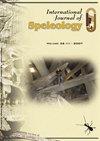新西兰威托莫Glowworm洞穴的人为影响:小气候管理方法
IF 1.3
4区 地球科学
Q3 GEOSCIENCES, MULTIDISCIPLINARY
引用次数: 2
摘要
怀托摩萤火虫洞是一个参观人数众多的洞穴,其中最引人注目的是观看一大群萤火虫的生物发光展示。参观水平导致人为二氧化碳的积累,其程度可能导致洞穴的腐蚀。洞穴采用烟囱式通风,根据洞穴与外部环境的空气密度差异,空气向上或向下通过主要的洞穴室。缺乏气流导致二氧化碳积聚;然而,不受限制的气流会吸入凉爽干燥的空气,这对萤火虫是有害的。因此,通过控制密封最上层入口的门的打开和关闭来管理气流,防止干燥条件下的通风,并在需要清除二氧化碳和流入空气相对湿度较高时促进通风。洞穴中的微气候传感器网络可以预测和管理通风模式。管理导致全年气流不对称,这对洞穴温度有流动效应。小气候监测支持目前的管理做法,即当有人在洞穴中时,使用门控制来加强洞穴通风。抑制气流,尤其是在冬季,可以减少干燥空气的进入。本文章由计算机程序翻译,如有差异,请以英文原文为准。
Anthropogenic impacts on the Glowworm Cave, Waitomo, New Zealand: a microclimate management approach
Waitomo Glowworm Cave is a highly visited cave where the highlight is viewing the bioluminescence display of a large colony of glowworms. The visitation levels result in the build-up of anthropogenic CO2, to the extent that it could cause corrosion of speleothems. The cave experiences chimney-effect ventilation with air flowing either upward or downward through the main cave chambers depending on air density differences between the cave and the outside environment. Lack of airflow leads to CO2 build-up; however, unrestricted airflow can draw in cool, dry air which is harmful to the glowworms. Consequently, airflow is managed by controlling the opening and closing of a door that seals the upper-most entrance, preventing ventilation under drying conditions and promoting ventilation when it is necessary to clear CO2 and when inflowing air has high relative humidity. A network of microclimate sensors in the cave allows prediction and management of the ventilation pattern. Management leads to asymmetric airflow through the year, which has a flow-on effect on cave temperature. Microclimate monitoring supports the current management practices that use door control to enhance cave ventilation when people are in the cave. Suppressing airflow, especially in winter, reduces the introduction of dry air.
求助全文
通过发布文献求助,成功后即可免费获取论文全文。
去求助
来源期刊

International Journal of Speleology
地学-地球科学综合
CiteScore
3.10
自引率
23.10%
发文量
12
审稿时长
>12 weeks
期刊介绍:
The International Journal of Speleology has the aim to get cave and karst science known to an increasing number of scientists and scholars. The journal therefore offers the opportunity to all scientists working in and on karst to publish their original research articles or their review papers in an open access, high quality peer reviewed scientific journal at no cost. The journal offers the authors online first, open access, a free PDF of their article, and a wide range of abstracting and indexing services.
 求助内容:
求助内容: 应助结果提醒方式:
应助结果提醒方式:


